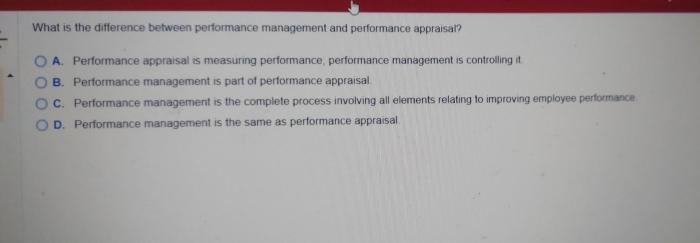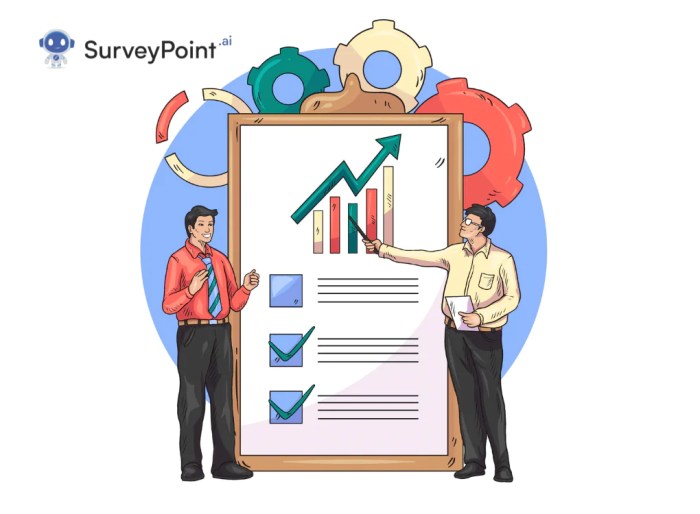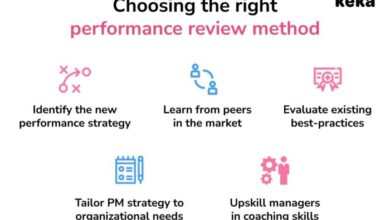
Performance management vs performance appraisal – Performance management vs. performance appraisal sets the stage for understanding how organizations effectively evaluate and improve employee contributions. This exploration delves into the nuances of continuous feedback versus formal evaluations, examining how different strategies impact employee growth and organizational success.
We’ll explore the core components of a robust performance management system, contrasting them with the more traditional performance appraisal approach. Understanding these distinctions is crucial for any organization seeking to cultivate a high-performing workforce. We’ll also consider the goals, processes, and technological tools that support both strategies.
Defining Performance Management and Appraisal
Performance management is a continuous process focused on aligning individual and organizational goals. It’s not a one-time event but rather a dynamic system for improving employee performance and contributing to overall business success. This contrasts sharply with the traditional, often static, approach of performance appraisal, which frequently becomes a box-checking exercise. A well-structured performance management system fosters a culture of continuous improvement, feedback, and development.Performance management encompasses a range of activities, from setting clear expectations and providing ongoing feedback to identifying development opportunities and recognizing achievements.
This holistic approach moves beyond simply evaluating past performance to proactively shaping future success. By integrating performance management into the fabric of the organization, companies can foster a more engaged and productive workforce.
Defining Performance Management
Performance management is a systematic process that ensures employees’ efforts are aligned with the organization’s strategic objectives. It goes beyond periodic evaluations and encompasses a continuous cycle of goal setting, performance monitoring, feedback, and development. A robust performance management system includes several key components.
Core Components of a Robust Performance Management System
A comprehensive performance management system comprises several key elements:
- Clear Goals and Objectives: Establishing specific, measurable, achievable, relevant, and time-bound (SMART) goals that align with organizational objectives. This clarity ensures everyone understands their role in the overall strategy.
- Regular Feedback and Coaching: Providing consistent feedback, both positive and constructive, throughout the performance cycle. This ongoing dialogue fosters improvement and addresses any challenges early on. Coaching supports employees in developing the skills and knowledge needed to succeed.
- Performance Monitoring and Measurement: Tracking progress against established goals using relevant metrics and data. This data-driven approach provides insights into performance trends and areas for improvement.
- Development and Training Opportunities: Identifying and providing opportunities for skill enhancement and knowledge acquisition. This proactive approach supports employees in reaching their full potential and staying current with industry best practices.
- Recognition and Rewards: Acknowledging and rewarding exceptional performance to reinforce desired behaviors and motivate employees. A well-structured system recognizes contributions at all levels, fostering a positive work environment.
Performance Management vs. Performance Appraisal
Performance management is a continuous process, while performance appraisal is a formal evaluation. Performance management focuses on ongoing feedback, development, and improvement, whereas performance appraisal is typically a periodic review of past performance.The difference is crucial. Performance management proactively shapes performance, while appraisal mostly assesses it after the fact. A well-implemented performance management system transforms performance appraisal from a static review into a dynamic tool for growth and development.
Performance management, unlike performance appraisal, is a continuous process, not a one-off event. It’s about fostering a culture of ongoing feedback and development, much like how the Motorola XOOM, designed for heavy meddling ( motorola xoom designed for heavy meddling ), allows for deep customization. This ongoing interaction, key to performance management, ultimately leads to better outcomes for everyone involved, a far cry from the static nature of traditional appraisals.
Examples of Performance Management Strategies
Performance management strategies vary depending on the industry and work environment. Examples include:
- Project-based environments: Project managers often use regular check-ins and progress reports to monitor team performance and ensure deliverables are met on time and within budget. Feedback loops are crucial for adaptation and adjustments.
- Customer-facing roles: Companies in service industries emphasize ongoing feedback from customers and employees to understand areas for improvement in service delivery and employee support. Customer satisfaction scores and employee feedback are key performance indicators.
- Creative industries: In creative fields, performance management often involves providing constructive feedback on projects, fostering collaboration, and encouraging innovative thinking. Metrics might include the quality and originality of work produced.
Comparison Table: Performance Management and Appraisal
| Key Characteristic | Performance Management | Performance Appraisal |
|---|---|---|
| Frequency | Continuous | Periodic (e.g., annually) |
| Purpose | Alignment with organizational goals, ongoing development, feedback, and improvement | Evaluating past performance, providing formal feedback, and determining compensation or promotions |
| Outcomes | Improved employee performance, increased engagement, enhanced organizational effectiveness | Formal documentation of performance, basis for compensation decisions, identification of training needs |
Goals and Objectives

Performance management and appraisal systems are not just about evaluating past performance; they are powerful tools for driving organizational success. Effective alignment with strategic goals ensures that individual employee efforts contribute directly to the overall mission and vision. This alignment, in turn, fosters a culture of accountability and motivates employees to achieve ambitious targets.Strategic alignment is crucial because it ensures that individual employee efforts directly support the organization’s overall goals.
By integrating performance management and appraisal with the strategic direction of the company, you can ensure that everyone is working towards the same objectives. This creates a unified and productive workforce.
Strategic Alignment of Performance Management and Appraisal
Performance management and appraisal systems should be deeply intertwined with the organization’s strategic goals. This means clearly defining how individual contributions impact broader organizational objectives. A well-defined process ensures that employees understand how their work directly contributes to the company’s success, which motivates them to strive for excellence. For instance, if a company’s strategic goal is to increase market share, performance management should include KPIs that measure sales growth, new customer acquisition, and market penetration.
Key Performance Indicators (KPIs), Performance management vs performance appraisal
Identifying relevant KPIs is essential for effective performance management and appraisal. These metrics provide concrete measures of success against predetermined goals. KPIs must be specific, measurable, achievable, relevant, and time-bound (SMART). For example, a KPI for a sales representative might be “increase sales by 15% in Q3.” This is a quantifiable, achievable goal that directly relates to the company’s strategic objective of boosting revenue.
Setting SMART Goals
Setting SMART goals for employees is paramount for effective performance management. SMART goals are specific, measurable, achievable, relevant, and time-bound. A poorly defined goal is almost certainly not going to be met. For instance, a goal of “improving customer service” is too vague. A better, SMART goal would be “reduce customer complaint rate by 10% by the end of Q4.”
Linking Individual Employee Goals to Organizational Objectives
Linking individual employee goals to organizational objectives is critical for maintaining focus and ensuring collective progress. This involves clearly defining how each employee’s role contributes to the overall strategic plan. A cascading approach, where top-level objectives are broken down into departmental and individual targets, ensures alignment across all levels of the organization. For example, if the company’s goal is to increase production, individual production targets are set for assembly line workers, who, in turn, will meet departmental targets.
Types of KPIs for Different Roles and Departments
The following table illustrates different types of KPIs relevant to various roles and departments, showcasing their connection to performance management and appraisal:
| Role/Department | KPIs | Connection to Performance Management/Appraisal |
|---|---|---|
| Sales Representatives | Sales volume, conversion rate, customer acquisition cost | Evaluates individual and team performance in achieving sales targets and market penetration. |
| Marketing Team | Website traffic, lead generation, social media engagement | Measures the team’s effectiveness in driving brand awareness and generating leads. |
| Customer Service Representatives | Average resolution time, customer satisfaction scores, first call resolution rate | Assesses the quality of service and efficiency in addressing customer needs. |
| Production Workers | Units produced per hour, defect rate, adherence to quality standards | Evaluates productivity, quality control, and efficiency in meeting production targets. |
| Project Managers | Project completion on time and within budget, project success rate, stakeholder satisfaction | Assesses the ability to manage resources and deliver projects successfully. |
Processes and Methods: Performance Management Vs Performance Appraisal
Implementing a robust performance management system requires a structured approach. This involves careful planning, clear communication, and consistent application of established processes. It’s not a one-time event but a continuous cycle of improvement, feedback, and development. The methods used to collect performance data and conduct reviews are crucial in fostering a positive and productive work environment.Effective performance management hinges on a systematic approach to data collection and review.
Performance management, a continuous process, differs significantly from the more traditional performance appraisal, a one-off event. Just like the seemingly random generation of public crypto keys isn’t as random as we might think, random public crypto keys aren’t so random , subtle biases and patterns can creep into performance assessments. Ultimately, both performance management and performance appraisal systems need careful consideration to avoid unintentional inaccuracies, and to ensure a fair and effective evaluation process.
This approach empowers individuals to understand their strengths and areas for improvement, leading to enhanced performance and overall organizational success. It is vital to have a clear, documented process that is easily understood and implemented by all stakeholders.
Implementing a Performance Management System
A well-structured performance management system involves a series of steps. These steps ensure that the system is implemented smoothly and effectively, leading to better employee engagement and organizational performance.
- Establish Clear Goals and Objectives: Define specific, measurable, achievable, relevant, and time-bound (SMART) goals for the organization and individual roles. This clarity provides a framework for evaluating performance and ensuring alignment with organizational objectives.
- Develop Performance Standards: Create detailed descriptions of expected performance levels for each role and responsibility. These standards act as benchmarks for evaluating employee performance and should be transparent and easily understood.
- Select and Train Performance Reviewers: Choose reviewers with the necessary knowledge and skills to conduct fair and constructive performance reviews. Provide them with comprehensive training on conducting reviews, offering feedback, and using the performance management system.
- Establish a Feedback Cycle: Design a regular feedback schedule to ensure ongoing communication and performance improvement. Regular feedback sessions, whether formal or informal, help maintain momentum and address issues proactively.
- Document Everything: Maintain detailed records of performance reviews, feedback sessions, and any performance-related actions. This documentation serves as a vital record of progress, provides evidence for performance evaluations, and aids in legal compliance.
- Regularly Review and Refine: The performance management system should be reviewed and refined periodically to ensure its effectiveness and relevance to the evolving needs of the organization.
Methods for Collecting Performance Data
Various methods can be used to gather comprehensive performance data. These methods provide a holistic view of an employee’s performance, encompassing their contributions, strengths, and areas for development.
- Self-Assessments: Employees assess their own performance against established standards and objectives. This method fosters self-awareness and encourages introspection. It is a crucial component of a balanced performance review process, offering employees a platform to reflect on their achievements and contributions.
- Peer Reviews: Colleagues assess each other’s performance based on their observations and interactions. This method offers a valuable perspective from individuals who work alongside the employee daily. Peer reviews provide a diverse range of input, highlighting both strengths and areas needing improvement from a collaborative standpoint.
- 360-Degree Feedback: This comprehensive approach involves collecting feedback from various stakeholders, including supervisors, peers, subordinates, and even customers. It provides a rich and multi-faceted perspective, encompassing different aspects of an employee’s performance.
Conducting Effective Performance Reviews
Performance reviews should be more than just a formality. They should be a constructive dialogue focused on growth and development. This approach fosters a culture of continuous improvement and supports employees in achieving their full potential.
- Prepare in Advance: Thoroughly review the employee’s performance, using documented data and feedback from multiple sources. This preparation allows for a more focused and productive review.
- Create a Safe and Supportive Environment: Foster an atmosphere where open communication and constructive criticism are encouraged. This environment encourages honest feedback and promotes a positive exchange of ideas.
- Focus on Specific Behaviors and Examples: Instead of general statements, provide specific examples of the employee’s actions and accomplishments. This helps ensure that the feedback is actionable and impactful.
- Establish Clear Expectations for Improvement: If areas for improvement are identified, clearly Artikel the steps needed to address them. Provide resources and support to facilitate progress.
- Document Key Discussions: Record the key takeaways and agreed-upon actions from the review. This serves as a valuable reference point for future performance evaluations and for tracking progress.
Importance of Regular Feedback Sessions
Regular feedback sessions are essential for ongoing performance improvement. These sessions foster a culture of continuous development and support employees in understanding their strengths and areas for growth.
- Proactive Issue Resolution: Regular feedback sessions allow for timely identification and resolution of performance issues before they escalate. This proactive approach prevents problems from impacting productivity or morale.
- Enhanced Employee Engagement: Regular feedback sessions demonstrate a commitment to employee growth and development. This fosters a sense of value and encourages greater engagement in their work.
- Continuous Improvement: Regular feedback loops facilitate a continuous cycle of improvement. Employees can adjust their approach based on ongoing feedback, resulting in increased productivity and effectiveness.
Performance Review Methods
| Method | Advantages | Disadvantages |
|---|---|---|
| Self-Assessment | Promotes self-awareness, encourages reflection | May be subjective, potential for underreporting |
| Peer Review | Provides diverse perspectives, highlights teamwork aspects | Potential for bias, may not always be accurate |
| 360-Degree Feedback | Comprehensive view, identifies blind spots | Can be time-consuming, requires careful coordination |
| Supervisor Review | Provides direct oversight, aligns with organizational goals | May be subjective, may not capture all aspects of performance |
Performance Improvement Strategies

Performance improvement is a crucial aspect of any effective performance management system. It’s not just about identifying areas needing work, but actively supporting employees in enhancing their skills and achieving their full potential. A robust strategy for improvement fosters a culture of continuous learning and growth, ultimately benefiting both the individual and the organization.Addressing performance gaps proactively, through constructive feedback and tailored support, is key to preventing issues from escalating.
This approach promotes a positive work environment where employees feel empowered to develop and contribute meaningfully. Effective performance improvement strategies often involve a combination of coaching, training, and clear communication to help employees understand expectations and identify the steps required for improvement.
Providing Constructive Feedback and Coaching
Constructive feedback is a cornerstone of performance improvement. It involves providing specific, actionable, and encouraging input to help employees understand areas where they can enhance their performance. This feedback should focus on observable behaviors and outcomes, rather than personal attacks. Coaches play a critical role in guiding employees through the improvement process. They act as mentors, offering support and guidance, while helping employees develop strategies for addressing challenges.
Active listening, empathy, and a focus on solutions are essential components of effective coaching.
The Role of Training and Development
Investing in training and development programs is a significant factor in performance enhancement. These programs provide employees with the necessary skills, knowledge, and tools to excel in their roles. Targeted training can address specific performance gaps, improve efficiency, and increase employee satisfaction. Organizations that prioritize training and development demonstrate a commitment to their employees’ growth and success.
This commitment often leads to higher levels of employee engagement and retention.
Addressing Performance Gaps and Identifying Areas for Improvement
Identifying performance gaps is a critical step in the performance improvement process. This involves carefully analyzing employee performance data, including metrics, feedback, and observations. Through this analysis, potential areas for improvement become clear. By understanding the root causes of performance issues, organizations can implement targeted interventions to address them. Addressing gaps effectively often involves a multi-faceted approach, combining training, coaching, and process adjustments.
Examples of Successful Performance Improvement Plans
A successful performance improvement plan typically involves a clear definition of the performance issue, specific, measurable, achievable, relevant, and time-bound (SMART) goals, and a plan for achieving those goals. It should include regular check-ins and progress evaluations. For example, a sales representative struggling with meeting quotas might have a plan that includes additional training on sales techniques, mentorship from a more experienced colleague, and a revised sales strategy.
Another example could be a team facing communication challenges. A performance improvement plan might involve training sessions on active listening, team-building exercises, and regular team meetings focused on clear communication protocols.
Performance Improvement Strategies Across Roles
| Role | Strategy | Effectiveness (High/Medium/Low) | Example |
|---|---|---|---|
| Sales Representative | Sales training, mentorship, revised sales strategies | High | Providing additional sales training and one-on-one coaching to improve closing rates. |
| Project Manager | Project management training, time management techniques, improved communication | Medium | Implementing time management workshops and assigning a mentor to improve project delivery times. |
| Customer Service Representative | Active listening training, conflict resolution, improved communication protocols | High | Offering training on active listening and conflict resolution to improve customer satisfaction scores. |
| Software Engineer | Technical training, mentorship, code review sessions | Medium | Providing technical training in new programming languages and code review sessions to improve coding efficiency. |
Performance Management and Appraisal in Different Contexts
Performance management and appraisal are crucial for any organization, but their application varies significantly depending on the industry, organizational structure, and cultural context. Understanding these nuances allows for more effective implementation and improved employee performance. This exploration delves into how performance management and appraisal methods adapt to diverse environments, from manufacturing to technology, and remote or hybrid work models.Performance management and appraisal aren’t one-size-fits-all.
A meticulous understanding of the specific context—including industry norms, cultural sensitivities, and organizational structures—is paramount for crafting effective strategies. This involves recognizing that the same set of tools may yield different results in different environments. This necessitates tailoring approaches to align with the unique characteristics of each situation.
Performance Management in Manufacturing Industries
Manufacturing industries often emphasize quantifiable metrics and adherence to established processes. Performance appraisals typically focus on output, quality control, and adherence to safety regulations. Regular feedback and training are crucial to ensure consistent production and quality standards. Continuous improvement programs, such as Six Sigma methodologies, often form an integral part of performance management, promoting a culture of process optimization and continuous learning.
Performance Management in Service Industries
Service industries, in contrast, often prioritize customer satisfaction, interpersonal skills, and adaptability. Performance appraisals in these sectors might evaluate responsiveness, communication effectiveness, and problem-solving abilities. Training programs are critical to developing customer service skills and fostering positive client interactions. Focus on client feedback and internal feedback loops are essential in these environments.
Performance Management in Technology Industries
Technology companies often value innovation, problem-solving skills, and collaboration. Performance appraisals in this sector often emphasize creativity, adaptability to new technologies, and teamwork. Regular feedback sessions, designed to encourage experimentation and knowledge sharing, are frequently employed. The ability to quickly adapt to evolving technologies and market demands is highly valued in this industry.
Challenges in Different Organizational Structures
Different organizational structures pose unique challenges. In hierarchical structures, clear reporting lines and well-defined roles are vital. In flatter structures, collaboration and shared responsibility are more important, demanding flexibility in performance management strategies. Performance appraisal in matrix organizations needs to account for multiple reporting lines and shared responsibilities.
Adapting to Remote and Hybrid Work Environments
Remote and hybrid work environments necessitate adaptations to traditional performance management approaches. Regular virtual check-ins, project-based assessments, and clear communication protocols are vital for maintaining accountability and transparency. Performance reviews may need to incorporate digital tools and platforms to track progress and provide feedback. Trust, transparency, and clear communication are critical to maintaining motivation and productivity in remote work settings.
Performance Management in Diverse Teams
Diverse teams bring a wealth of perspectives and experiences. Performance management practices must be inclusive and sensitive to cultural differences. Recognizing individual strengths and acknowledging varied communication styles are crucial. Fair and consistent evaluation criteria, applicable to all team members, are essential for preventing bias and promoting a sense of fairness.
Thinking about performance management versus performance appraisal? It’s more than just a difference in terminology; it’s about a shift in focus. Modern performance management is about continuous feedback and development, fostering a growth mindset, while performance appraisal often feels like a one-off event. This evolution in thinking mirrors the exciting possibilities opening up for mobile devices like BlackBerry backups and tablets, as seen in juicier prospects for blackberry backup and a tablet too.
Ultimately, both approaches aim to improve employee performance, but the continuous feedback loop in performance management creates a much more dynamic and effective system.
Table: Performance Management Practices in Various Industries
| Industry | Focus Areas | Cultural Considerations | Adaptation Strategies |
|---|---|---|---|
| Manufacturing | Output, Quality, Safety | Strict adherence to procedures, hierarchy | Clear KPIs, standardized training |
| Service | Customer Satisfaction, Interpersonal Skills | Cultural sensitivity, emphasis on relationships | Customer feedback loops, tailored training |
| Technology | Innovation, Problem-Solving, Collaboration | Rapid change, emphasis on results | Regular feedback, agile project management |
Technology and Tools
Performance management is evolving rapidly, and technology plays a crucial role in streamlining processes and enhancing effectiveness. From automating repetitive tasks to leveraging data analytics for insightful decision-making, technology is transforming how organizations manage and improve employee performance. This section will explore how technology supports performance management and appraisal, highlighting key tools and strategies.Technology is fundamentally changing the landscape of performance management.
Modern tools offer a more dynamic and data-driven approach to evaluating and improving employee performance, moving beyond traditional paper-based methods. These tools can enhance communication, track progress, and provide valuable insights that were previously unavailable.
Automated Performance Management Tasks
Automation of performance management tasks is transforming how companies manage employee performance. Automating repetitive tasks, such as scheduling performance reviews, collecting feedback, and generating reports, frees up managers’ time for more strategic activities. This increased efficiency leads to more effective use of resources and a more streamlined performance management process.
- Scheduling and reminders: Software can automatically schedule performance reviews, send reminders to both employees and managers, and track deadlines, ensuring that reviews happen on time and are completed effectively.
- Feedback collection: Tools can facilitate regular feedback collection through surveys, questionnaires, and 360-degree feedback mechanisms. This ongoing feedback loop is vital for identifying areas of improvement and providing support to employees.
- Performance review documentation: Automated systems can manage and store performance review documentation, ensuring compliance and accessibility. This includes storing performance goals, feedback, and employee contributions.
Data Analytics in Performance Management
Data analytics plays a significant role in performance management. By analyzing data related to employee performance, companies can gain valuable insights into trends, identify areas for improvement, and make data-driven decisions. This can lead to more targeted interventions and a more effective approach to improving employee performance.
- Identifying performance trends: Data analysis can uncover patterns and trends in employee performance, revealing areas where employees excel and areas needing attention. This helps tailor interventions for specific needs.
- Performance prediction: Predictive analytics can help forecast future performance based on historical data, allowing proactive measures to be implemented to support and improve employee performance.
- Identifying training needs: Analysis of performance data can pinpoint skill gaps and areas where employees need additional training or development. This targeted approach optimizes training resources and improves employee effectiveness.
Performance Management Platforms
Performance management platforms provide a centralized system for managing the entire performance management process. These platforms streamline communication, automate tasks, and offer valuable insights into employee performance. They are often integrated with other HR systems, providing a comprehensive view of employee data.
- Centralized data storage: Performance management platforms provide a centralized repository for performance-related data, including goals, reviews, feedback, and development plans. This ensures data accessibility for managers and employees.
- Improved communication: Platforms facilitate communication between managers and employees regarding performance expectations, goals, and progress. This clear communication is essential for effective performance management.
- Streamlined workflows: These platforms streamline workflows by automating tasks, reducing manual effort, and improving efficiency.
Performance Management Software Comparison
Various software options are available for automating performance management processes. Choosing the right software depends on specific needs and budget constraints. Below is a table highlighting key features of different performance management software.
| Software | Key Features |
|---|---|
| BambooHR | Performance reviews, goal setting, 360-degree feedback, compensation management |
| Workday | Comprehensive HR suite, including performance management, compensation, and talent management modules |
| Culture Amp | Employee engagement and performance data analysis, 360-degree feedback, goal setting |
| Zoho People | Performance reviews, goal setting, feedback management, compensation management |
Measuring and Evaluating Effectiveness
Performance management and appraisal systems are only as good as their ability to demonstrate effectiveness. A robust evaluation process is crucial for identifying areas of strength, pinpointing weaknesses, and ultimately, driving continuous improvement. Understanding how to measure the impact of these systems is vital for organizations seeking to maximize employee performance and organizational success.A thorough evaluation should consider multiple factors, including employee feedback, key performance indicators, and overall organizational goals.
This approach ensures a holistic perspective, leading to a more accurate assessment of the system’s efficacy.
Methods for Measuring Effectiveness
A variety of methods can be used to assess the effectiveness of performance management and appraisal systems. These methods range from quantitative analysis of key performance indicators to qualitative assessments of employee satisfaction and engagement. A comprehensive approach is crucial for a complete picture.
- Quantitative analysis: Tracking key performance indicators (KPIs) is essential for understanding the tangible impact of the system. Examples include increased productivity, reduced errors, improved customer satisfaction scores, and decreased employee turnover. Analyzing these metrics over time provides valuable insights into the system’s effectiveness.
- Qualitative analysis: Gathering employee feedback through surveys, interviews, and focus groups offers valuable insights into the system’s perceived value and areas needing improvement. Understanding employee perceptions is essential for adapting the system to better meet their needs.
- Comparative analysis: Benchmarking against industry standards and best practices provides a framework for identifying areas where the system excels and areas needing attention. This approach fosters continuous improvement by identifying best practices in similar organizations.
Tracking Key Performance Indicators (KPIs)
Tracking KPIs provides concrete data to measure the system’s success. This involves identifying metrics directly related to the goals of the performance management system. These metrics must be quantifiable and readily measurable to provide accurate data.
- Defining KPIs: KPIs should be specific, measurable, achievable, relevant, and time-bound (SMART). For example, instead of “improve customer satisfaction,” a KPI could be “increase customer satisfaction scores by 15% within the next quarter.” This clarity is essential for accurate tracking and measurement.
- Regular Monitoring: Regularly monitoring KPIs allows for timely adjustments and interventions if necessary. This ongoing tracking ensures that the system remains aligned with organizational goals and that any potential issues are identified and addressed promptly.
- Trend Analysis: Analyzing trends in KPIs over time provides a deeper understanding of the system’s long-term impact. This historical data allows for predictions and adjustments for future performance.
Employee Feedback and Satisfaction
Employee feedback is invaluable in evaluating the effectiveness of performance management systems. Understanding employee satisfaction is critical to maintaining a motivated and engaged workforce.
- Collecting feedback: Employ various methods, including surveys, focus groups, and one-on-one interviews, to gather comprehensive employee feedback on the system’s strengths and weaknesses. A combination of these methods offers a more robust and nuanced understanding of the employees’ perspectives.
- Analyzing feedback: Analyze the collected feedback to identify recurring themes and patterns. Addressing these recurring issues through targeted improvements will significantly enhance the system’s effectiveness.
- Actionable Insights: Feedback should lead to actionable insights, guiding the development of improved performance management processes and strategies.
Identifying Areas for Improvement
Regular evaluation of the performance management system is essential for identifying areas requiring improvement. This proactive approach ensures the system remains relevant and effective in supporting organizational objectives.
- Employee input: Actively solicit employee feedback to identify areas where the system is lacking or could be improved. Employee input is crucial for ensuring the system meets the needs of the workforce.
- Performance reviews: Thorough performance reviews can pinpoint areas where the system could better support individual development and goal achievement. By understanding specific challenges and opportunities, the system can be refined.
- System review: Periodically review the entire system to ensure it remains aligned with current business objectives. This ensures the system stays relevant and effective over time.
Metrics for Evaluating Effectiveness
The table below Artikels various metrics for assessing the effectiveness of performance management and appraisal programs. These metrics provide a framework for understanding the system’s impact on different aspects of the organization.
| Metric | Description | How to Measure |
|---|---|---|
| Employee Satisfaction | Employee perception of the fairness and usefulness of the system. | Surveys, focus groups, feedback forms |
| Productivity | Measure of output per employee. | Track output metrics, analyze work completion times |
| Employee Turnover | Rate at which employees leave the organization. | Calculate employee turnover rate over a period |
| Training and Development | Measure of employee development opportunities. | Track participation in training programs, skill improvement |
| Performance Improvement | Track progress in achieving performance goals. | Analyze performance reviews, track progress on goals |
Concluding Remarks
In conclusion, performance management, emphasizing continuous feedback and development, offers a more dynamic approach compared to the more traditional performance appraisal. By understanding the strengths and weaknesses of each, organizations can tailor strategies to best support their employees and achieve their strategic objectives. Choosing the right approach depends heavily on organizational culture, industry, and the specific goals of the workforce.






